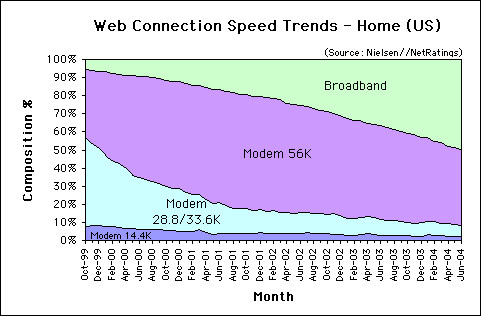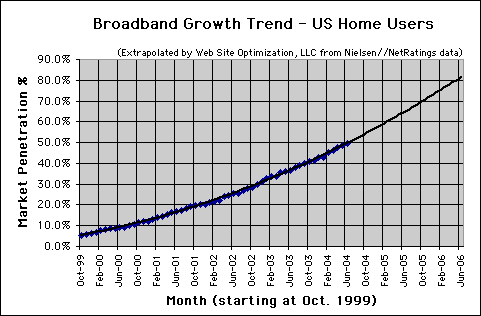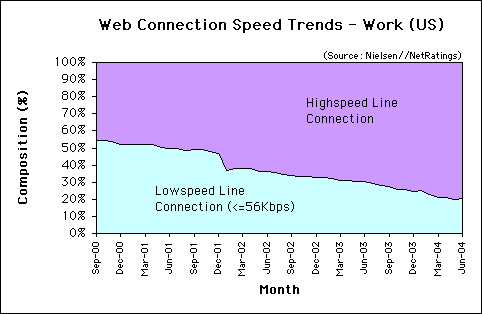New England and the Far West have the highest residential broadband penetration rates, according to the Leichtman Research Group. Hawaii, Massachusetts, and New Jersey top all U.S. states in residential broadband penetration. Overall, US broadband penetration grew by 0.87 percentage points in June, with 49.48% of active Internet users on high-speed connections at home. 50.52% of US home users dial into the Internet with “narrowband” connections of 56Kbps or less.
The charts below, derived from Nielsen//NetRatings and Leichtman Research Group data, show trends in connection speeds to the Internet for United States users and residential households.*
Home Connectivity in the US
As of June 2004, most users in the US connect to the Internet using dial-up modems of 56Kbps or less. 42.1% use 56Kbps modems, 6.04% use 28/33.3Kbps, and 2.38% use 14.4Kbps modems. In total, 50.52% of home users in the US connect to the Internet at 56Kbps or less (see Figure 1).
Web Connection Speed Trends – Home Users (US)
Figure 1: Web Connection Speed Trends – Home Users (US)
Source: Nielsen//NetRatings
Broadband Growth in the US
Broadband penetration in the US increased by 0.87 points in June. As of June 2004 broadband penetration was at 49.48%, up from 48.61% in May. This jump of 0.87 points is above the average increase in broadband of 0.79 points per month from October 1999 to May 2004. Extrapolating the data provided by Nielsen//NetRatings, broadband share in the US should exceed 50% by July of 2004 (see Figure 2).
Broadband Connection Speed Trend – Home Users (US)
Figure 2: Broadband Connection Speed Trend – Home Users (US)
Extrapolated from Nielsen//NetRatings data
Work Connectivity
Most workers in the US enjoy high-speed connections to the Internet. Most use a high-speed line such as a T1 connection, and share bandwidth between computers connected to an Ethernet network. The speed of each connection decreases as more employees hook up to the LAN. As of June of 2004, of those connected to the Internet, 79.5% of US users at work enjoy a high-speed connection, down from 79.8% in May. 20.5% connect from work at 56Kbps or less (see Figure 3).
Web Connection Speed Trends – Work Users (US)
Figure 3: Web Connection Speed Trends – Work Users (US)
Source: Nielsen//NetRatings
Broadband Penetration by State
While over one in five US households subscribes to broadband (21.3%), penetration rates vary by geographic region, according to the Leichtman Research Group.** New England and the far West lead the nation in residential broadband penetration (27.8% and 27.2% respectively), while the Southeast and the Rocky Mountain states have the lowest penetration rates (18.2% and 17.1% respectively). Over 70% of New Englanders get their broadband through cable, while Westerners split equally between cable and DSL.
The states with the highest residential broadband penetration are Hawaii, Massachusetts, New Jersey, Connecticut, New York, and California. The states with the lowest high-speed Internet penetration are Mississippi, South Dakota, Montana, Wyoming, and New Mexico (see Tables 1 & 2).
Top Six States in U.S. Residential Broadband Penetration
Hawaii35.0%Massachusetts32.2%New Jersey30.6%Connecticut29.1%New York28.6%California28.4%
| By State | Broadband Penetration |
|---|
Bottom Five States in U.S. Residential Broadband Penetration
Mississippi8.1%South Dakota8.5%Montana8.9%Wyoming10.2%New Mexico10.8%
| By State | Broadband Penetration |
|---|
Further Reading
- Leichtman Research Group
- Supplied the US region and state broadband penetration rates for residential households in Tables 1 and 2 for the Bandwidth Report. See the “New England and Far West Lead in Broadband Penetration” report of July 7, 2004.
- Nielsen//NetRatings
- Provides the US broadband data (percentage of active Internet users) for the Bandwidth Report.
*Note that Nielsen//NetRatings reports the percentage of active Internet users that use broadband from home, not broadband households. NetRatings uses a panel of 40,000 to 50,000 people with software meters installed on their computers. These meters detect connection speeds. Each month they do an enumeration study to call a number of people to calibrate the panel by adjusting weightings to match the population at large.
**The Leichtman Research data cited above is the penetration of residential and small business broadband subscribers (not including medium and large business, institutional and government) as defined by the FCC, divided by the total number of US Postal Service mailing addresses.
The Bandwidth Report is featured monthly on URLwire – news of useful and unique web content since 1994.



